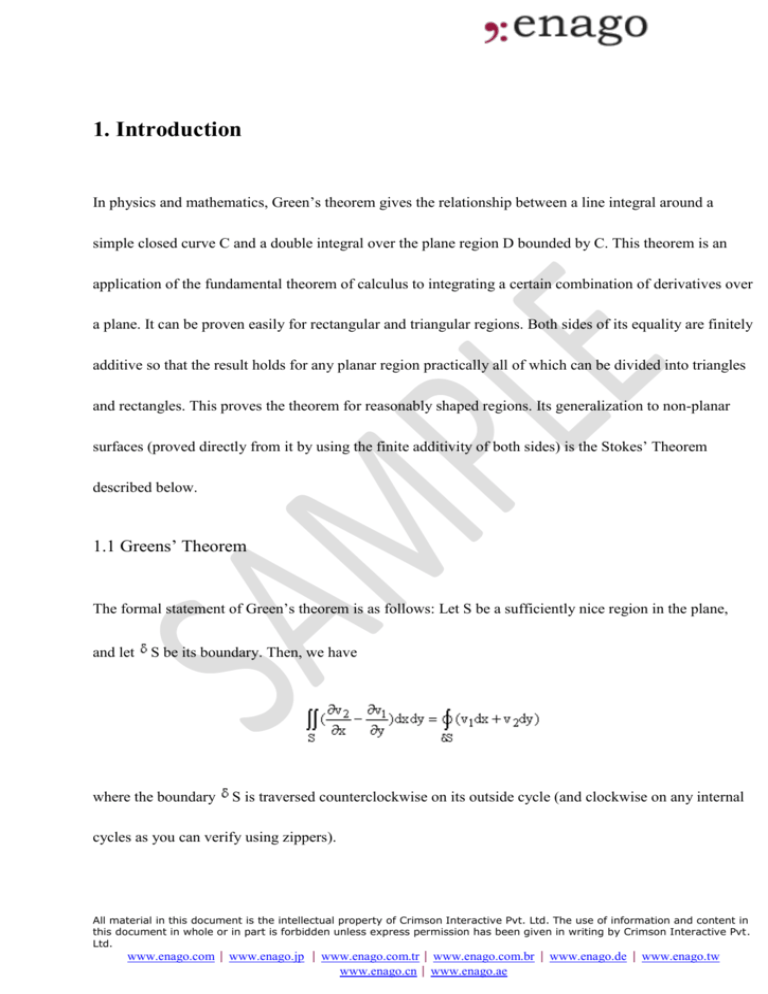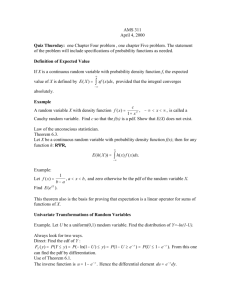Proofreading
advertisement

1. Introduction In physics and mathematics, Green’s theorem gives the relationship between a line integral around a simple closed curve C and a double integral over the plane region D bounded by C. This theorem is an application of the fundamental theorem of calculus to integrating a certain combination of derivatives over a plane. It can be proven easily for rectangular and triangular regions. Both sides of its equality are finitely additive so that the result holds for any planar region practically all of which can be divided into triangles and rectangles. This proves the theorem for reasonably shaped regions. Its generalization to non-planar surfaces (proved directly from it by using the finite additivity of both sides) is the Stokes’ Theorem described below. 1.1 Greens’ Theorem The formal statement of Green’s theorem is as follows: Let S be a sufficiently nice region in the plane, and let S be its boundary. Then, we have where the boundary S is traversed counterclockwise on its outside cycle (and clockwise on any internal cycles as you can verify using zippers). All material in this document is the intellectual property of Crimson Interactive Pvt. Ltd. The use of information and content in this document in whole or in part is forbidden unless express permission has been given in writing by Crimson Interactive Pvt. Ltd. www.enago.com | www.enago.jp | www.enago.com.tr | www.enago.com.br | www.enago.de | www.enago.tw www.enago.cn | www.enago.ae Meaning of this theorem: Green’s theorem is a form that the fundamental theorem of calculus takes in the context of integrals over planar re For a rectangle: By the ordinary fundamental theorem of calculus, we have . For a right triangle: For convenience, we choose a triangle bounded by line x = 0, y = 0, and . We similarly get . Rearrangement of the right hand side gives the theorem for rectangles and right triangles. It means that for R, a rectangle or right triangle in the x-y plane, (for which dS = dSk) we have . Both sides of this equation are finitely additive, i.e., if we take two disjoint regions and evaluate either one over both, we get the sum of their values on the two regions separately. This is true even if the regions All material in this document is the intellectual property of Crimson Interactive Pvt. Ltd. The use of information and content in this document in whole or in part is forbidden unless express permission has been given in writing by Crimson Interactive Pvt. Ltd. www.enago.com | www.enago.jp | www.enago.com.tr | www.enago.com.br | www.enago.de | www.enago.tw www.enago.cn | www.enago.ae share a common boundary, because the line integrals will cancel out over the common boundary that ceases to be a boundary. The result follows from additivity for any region that can be broken up into rectangles and triangles, which accounts for most regions we will encounter. All material in this document is the intellectual property of Crimson Interactive Pvt. Ltd. The use of information and content in this document in whole or in part is forbidden unless express permission has been given in writing by Crimson Interactive Pvt. Ltd. www.enago.com | www.enago.jp | www.enago.com.tr | www.enago.com.br | www.enago.de | www.enago.tw www.enago.cn | www.enago.ae







